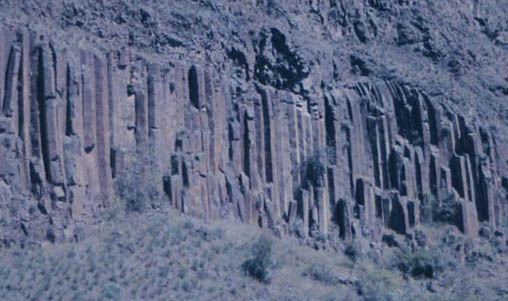Rhyolite
Rhyolite is an igneous rock in the class designated as "felsic" rock. This class of rock crystallizes from silicate minerals at relatively low temperatures and with relatively a high percentage of silica . It is at the low temperature extreme of the Bowen reaction series.
Rhyolite has a composition similar to granite but has a much smaller grain size. It is composed of the light-colored silicates and is usually buff to pink in color. Occasionally it is light gray. In texture it is classified as aphanitic. It frequently contains voids and glassy fragments, evidence of having formed in a surface environment with rapid cooling. Rhyolite is much less common than granite, but there are large lava flows and deposits of rhyolite in Yellowstone Park, Wyoming, USA.

Photo by Nydia Hanna
These rhyolite formations are along the Snake River in Hell's Canyon on the Idaho-Oregon border. The structures are referred to as "columnar jointing" and were the the most dramatic geologic features in appearance. There is much to be learned about geology in the canyon. It is like a time machine, which takes you back in history through several geologic eras.
The geologists on the trip referred to a study of Hell's Canyon by Tracy Vallier, "Islands and Rapids, a Geologic Story of Hell's Canyon." Vallier describes the areas where the columns occur as Permian rhyolite dikes. The columnar jointing is associated with lava flows and dikes of the Columbia River Basalt Group.
Igneous rock concepts
Reference
Lutgens & Tarbuck
Ch 3
| HyperPhysics***** Geophysics | R Nave |